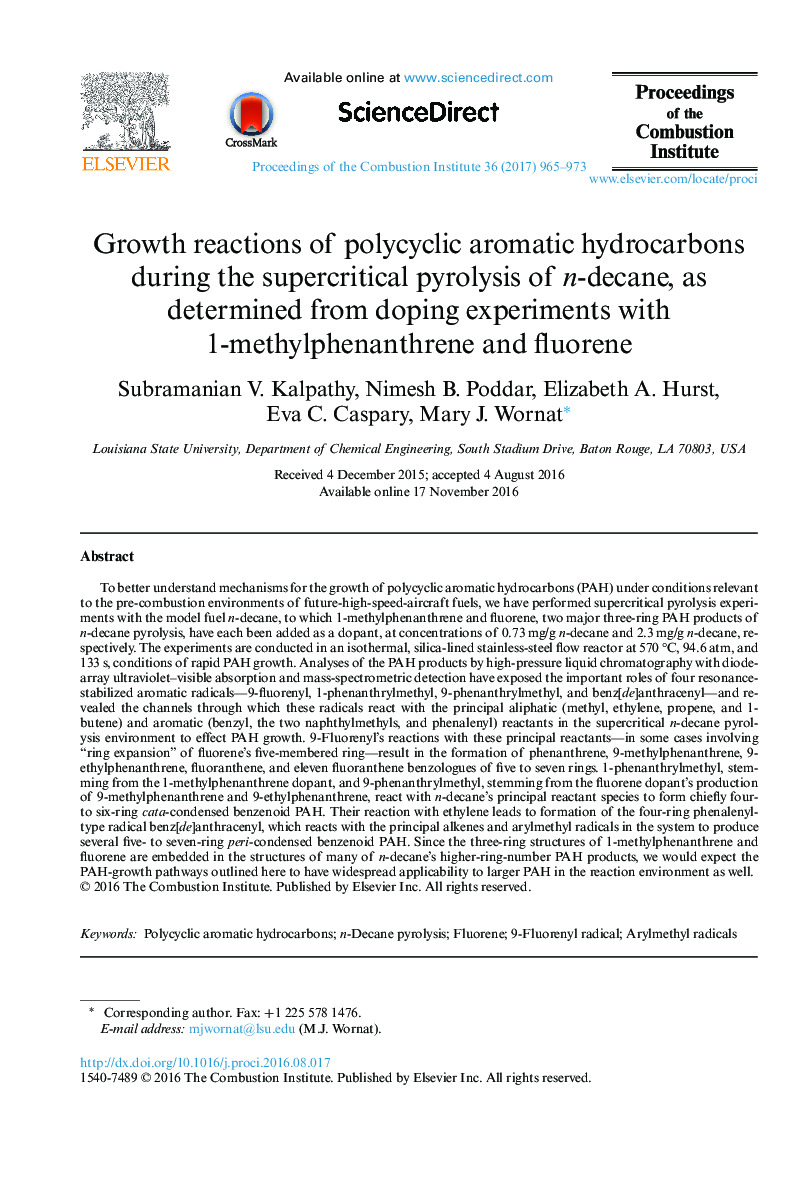| کد مقاله | کد نشریه | سال انتشار | مقاله انگلیسی | نسخه تمام متن |
|---|---|---|---|---|
| 6478258 | 1427917 | 2017 | 9 صفحه PDF | دانلود رایگان |

To better understand mechanisms for the growth of polycyclic aromatic hydrocarbons (PAH) under conditions relevant to the pre-combustion environments of future-high-speed-aircraft fuels, we have performed supercritical pyrolysis experiments with the model fuel n-decane, to which 1-methylphenanthrene and fluorene, two major three-ring PAH products of n-decane pyrolysis, have each been added as a dopant, at concentrations of 0.73 mg/g n-decane and 2.3 mg/g n-decane, respectively. The experiments are conducted in an isothermal, silica-lined stainless-steel flow reactor at 570 °C, 94.6 atm, and 133 s, conditions of rapid PAH growth. Analyses of the PAH products by high-pressure liquid chromatography with diode-array ultraviolet-visible absorption and mass-spectrometric detection have exposed the important roles of four resonance-stabilized aromatic radicals-9-fluorenyl, 1-phenanthrylmethyl, 9-phenanthrylmethyl, and benz[de]anthracenyl-and revealed the channels through which these radicals react with the principal aliphatic (methyl, ethylene, propene, and 1-butene) and aromatic (benzyl, the two naphthylmethyls, and phenalenyl) reactants in the supercritical n-decane pyrolysis environment to effect PAH growth. 9-Fluorenyl's reactions with these principal reactants-in some cases involving “ring expansion” of fluorene's five-membered ring-result in the formation of phenanthrene, 9-methylphenanthrene, 9-ethylphenanthrene, fluoranthene, and eleven fluoranthene benzologues of five to seven rings. 1-phenanthrylmethyl, stemming from the 1-methylphenanthrene dopant, and 9-phenanthrylmethyl, stemming from the fluorene dopant's production of 9-methylphenanthrene and 9-ethylphenanthrene, react with n-decane's principal reactant species to form chiefly four- to six-ring cata-condensed benzenoid PAH. Their reaction with ethylene leads to formation of the four-ring phenalenyl-type radical benz[de]anthracenyl, which reacts with the principal alkenes and arylmethyl radicals in the system to produce several five- to seven-ring peri-condensed benzenoid PAH. Since the three-ring structures of 1-methylphenanthrene and fluorene are embedded in the structures of many of n-decane's higher-ring-number PAH products, we would expect the PAH-growth pathways outlined here to have widespread applicability to larger PAH in the reaction environment as well.
Journal: Proceedings of the Combustion Institute - Volume 36, Issue 1, 2017, Pages 965-973